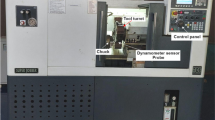Abstract
Wear is the main factor that causes most of the failures and reduces the lifetime of forming tools. The demand from industrial users for lower costs, higher productivity, and better quality is among the justifications for researching methods to increase the performance of these tools. In this work, the wear that occurs for hot forging tools was investigated. Herein for the first time, a high-velocity oxygen fuel (HVOF) technique was used for punch coatings in a hot forging process. Two punches coated by HVOF were analyzed for wear, one with chromium carbide (Cr3C2-NiCr) and the other with tungsten carbide (WC-CoCr). It was observed that both punches suffered a combination of several types of wear, mainly from thermal fatigue and abrasive wear. It was found that coating properties, such as roughness and hardness, influenced the wear mechanisms. The results showed that WC-CoCr presented a lower roughness and higher hardness, thereby offering a higher resistance against wear compared to Cr3C2-NiCr. The HVOF-coated punches showed a higher resistance against wear, which indicates that HVOF is a promising technique that is capable of increasing the lifetime of forging tools.
Similar content being viewed by others
References
Gong T, Yao P, Zuo X, Zhang Z, Xiao Y, Zhao L, Zhou H, Deng M, Wang Q, Zhong A (2016) Influence of WC carbide particle size on the microstructure and abrasive wear behavior of WC-10Co-4Cr coatings for aircraft landing gear. Wear 362–363:135–145
Budinski KG (2007) Guide to friction, wear, and erosion testing. Director. https://doi.org/10.1520/MNL56-EB
Gronostajski Z, Kaszuba M, Polak S, Zwierzchowski M, Niechajowicz A, Hawryluk M (2016) The failure mechanisms of hot forging dies. Mater Sci Eng A 657:147–160
Gronostajski Z, Kaszuba M, Hawryluk M, Zwierzchowski M (2014) A review of the degradation mechanisms of the hot forging tools. Arch Civ Mech Eng 14:528–539
Wang Q, Chen ZH, Ding ZX, Liu ZL (2009) Performance study of abrasive wear and erosive wear of WC-12Co coatings sprayed by HVOF. Tribol Int 42:340–344
Choi C, Groseclose A, Altan T (2012) Estimation of plastic deformation and abrasive wear in warm forging dies. J Mater Process Technol 212:1742–1752
Vashishtha N, Sapate SG (2017) Abrasive wear maps for high velocity oxy fuel (HVOF) sprayed WC-12Co and Cr3C2−25NiCr coatings. Tribol Int 114:290–305
Abachi S, Akk M, Ilhan G (2010) Tribology international wear analysis of hot forging dies. Tribol Int 43:467–473
Babu S (2004) A material based approach to creating wear resistant surfaces for hot forging. [Thesis]. Ohio: The Ohio State University
Al-Mutairi S, Hashmi MSJ, Yilbas BS, Stokes J (2015) Microstructural characterization of HVOF/plasma thermal spray of micro/nano WC–12%Co powders. Surf Coat Technol 264:175–186
Pawlowski L (2008) The science and engineering of thermal spray coatings. 2nd. West Sussex: John Wiley & Sons Ltd
Fauchais PL, Heberlein JVR, Boulos MI (2014) Thermal spray fundamentals. 1st. New York: Springer Science+Business Media
Berndt CC, Bernecki T (2004) Handbook of thermal spray technology. ASM, Ohio
Verdon C, Karimi A, Martin J-L (1998) A study of high velocity oxy-fuel thermally sprayed tungsten carbide-based coatings. Part 1: microstructures. Mater Sci Eng A 246:11–24
Yang Q, Senda T, Ohmori A (2003) Effect of carbide grain size on microstructure and sliding wear behavior of HVOF-sprayed WC-12% Co coatings. Wear 254:23–34
Metalurgica Rijeza. http://www.rijeza.com.br. Accessed 4 Jun 2018
Wood RJK (2010) Tribology of thermal sprayed WC-Co coatings. Int J Refract Met Hard Mater 28:82–94
Vignesh S, Shanmugam K, Balasubramanian V, Sridhar K (2017) Identifying the optimal HVOF spray parameters to attain minimum porosity and maximum hardness in iron based amorphous metallic coatings. Def Technol 13:101–110
Castro RDM, Rocha S, Isaías E, Curi M, Peruch F (2018) A comparison of microstructural, mechanical and tribological properties of WC-10Co4Cr - HVOF coating and hard chrome to use in hydraulic cylinders. Am J Mater Sci 8:15–26
Gahr KHZ (1998) Wear by hard particles. Tribol Int 31:587–596
Murthy JKN, Rao DS, Venkataraman B (2001) Effect of grinding on the erosion behaviour of a WC-Co-Cr coating deposited by HVOF and detonation gun spray processes. Wear 249:592–600
Chander S, Chawla V (2017) Failure of hot forging dies –an updated perspective. Mater Today Proc 4:1147–1157
Asgari H, Saha G, Mohammadi M (2016) Tribological behavior of nanostructured high velocity oxy-fuel (HVOF) thermal sprayed WC-17NiCr coatings. Ceram Int 43:2123–2135
Paschke H, Yilkiran T, Lippold L, Brunotte K, Weber M, Braeuer G, Behrens BA (2015) Adapted surface properties of hot forging tools using plasma technology for an effective wear reduction. Wear 330–331:429–438
Funding
The authors thank the CNPq (National Council for Scientific and Technological Development) for financial support.
Author information
Authors and Affiliations
Corresponding author
Rights and permissions
About this article
Cite this article
Marques, A.S., de Costa, L.D.L., dos Santos, G.R. et al. Wear study of hot forging punches coated with WC-CoCr and Cr3C2-NiCr through high-velocity oxygen fuel (HVOF) process. Int J Adv Manuf Technol 100, 3–11 (2019). https://doi.org/10.1007/s00170-018-2693-3
Received:
Accepted:
Published:
Issue Date:
DOI: https://doi.org/10.1007/s00170-018-2693-3




